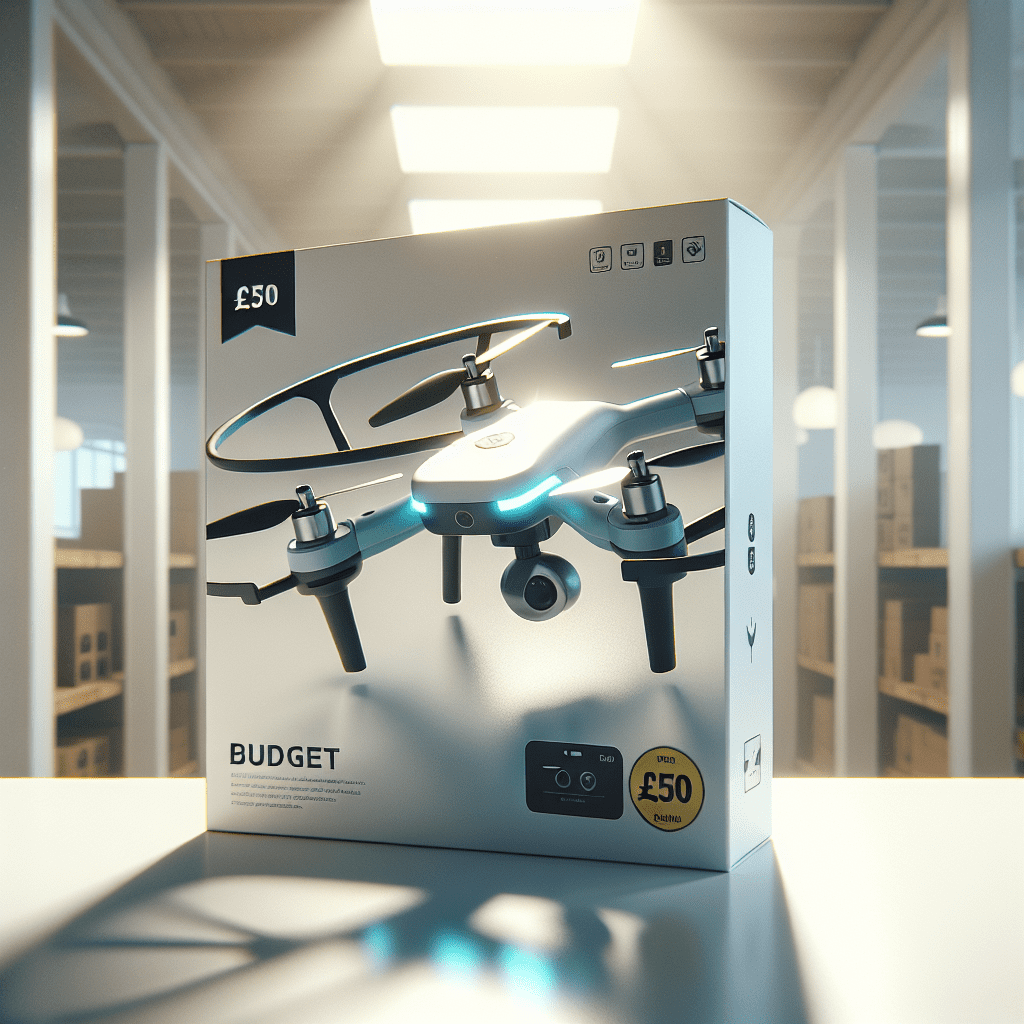Cheap Drones Under £50: Are They Worth It for Beginners?
In This Article
- Cheap Drones are excellent for beginners and casual users.
- Expect short flight times (5-10 minutes) and basic camera quality.
- Durability and portability are strong points in this category.
- Hidden costs may include spare batteries and propellers.
- Upgrade when you require stabilisation, GPS, or 1080p/4K footage.
Are Cheap Drones Really Worth Buying?
Understanding Value for Under £50
Cheap Drones offer an entryway into a hobby that once demanded a significant financial investment. Today, models costing less than £50 can be found sporting features that were once exclusive to higher-end variants. But while the affordability is attractive, it’s essential to understand what you’re trading off. In most cases, cheap drones serve as excellent introductory tools, ideal for beginners, young users, or those curious about aerial flight without a long-term commitment.

What sets these drones apart is their lightweight frame, simplified controls, and quick setup – all tailored to those flying for the first time or needing a portable gadget. However, enthusiasts seeking high-definition footage, advanced stabilisation, or sophisticated GPS tracking may find these models limiting. This does not mean cheap drones are disposable gadgets; rather, their value lies in providing education, entertainment, and experience at a fraction of the cost.
Main Features of Sub-£50 Drones
What You Actually Get
When evaluating drones under £50, focus is key. These compact machines typically offer a minimal yet surprisingly enjoyable suite of features. Most models are built using lightweight plastic shells, which help reduce manufacturing costs and improve flight stability in calm weather. Many offer 360-degree flips, headless mode operation, basic altitude hold, and LED lights for visibility. While the tech is basic, the feature set is often quite sufficient for indoor flying or short outdoor sessions.
“Buying a cheap drone can be the perfect hands-on experience to learn the basics of UAV flight before investing in something more advanced.”
Battery Life & Flight Experience
One crucial aspect of budget-friendly drones is the battery life, a factor that significantly impacts the flight experience. Most Cheap Drones in this price range utilise small lithium-ion batteries with capacities between 300mAh and 600mAh. In practical terms, this translates to flight times of around 5-10 minutes per full charge.
While this may seem brief, it is generally enough for beginners to get in some practice without risking battery fatigue or overheating. It’s also worth noting that many manufacturers include a second spare battery, effectively doubling the session duration. Recharging typically takes 60 to 90 minutes with standard USB cables included in the box, though third-party fast chargers are available for those looking to optimise their downtime.
Flight stability tends to be decent indoors, but wind can be a real obstacle outdoors given the drone’s light frame. The responsiveness of controls can vary between models, but most entry-level drones are designed with stability algorithms to prevent erratic flying, making the overall experience engaging albeit somewhat limited.
Camera Quality Expectations
Cheap Drones often include a built-in camera, though expectations should be tempered. Inexpensive models usually house cameras that offer 480p to 720p resolution, which can suffice for casual users or those experimenting with aerial footage for the first time. However, don’t expect cinematic-level clarity or stabilisation.
Fixed lenses without gimbals are common, so movements can appear jerky or blurred. While some models allow real-time video streaming to a smartphone via Wi-Fi, this feature is usually prone to lag and limited by short signal ranges – typically no more than 30 metres in open air. As such, these cameras are better suited to still image captures or close-range overhead shots rather than precision footage for editing or publication.
For educational purposes or basic social media content, however, they more than suffice. In fact, for children interested in trying out videography or budding content creators looking for an affordable aerial angle, a budget drone can be immensely rewarding.
Flight Controls and Usability for Beginners
Ease of use is one of the strongest selling points of sub-£50 drones. Manufacturers aim to reduce the learning curve by implementing beginner-friendly features such as one-button takeoff and landing, emergency stop, and headless mode directionality. These attributes can help new users build confidence without worrying about complex input commands or intricate calibration routines.
Some models now offer app-controlled flight, further minimising the need for external controllers. While these smartphone integrations are often rudimentary, they introduce digital feedback via on-screen joysticks, altitude indicators, and basic telemetry.
Most importantly, the simplicity of operation makes cheap drones well-suited for family environments, educational workshops, or personal leisure. You won’t find AI-enhanced piloting or auto-follow technology, but the essential flight management features are often more than sufficient for a rewarding hands-on experience. If you’re a parent researching first-time drones for your child, Learn more about Budget & Beginner Drone Buying Guides is a helpful guide on safety-first usage and parental controls.
Portability and Durability Factors
Compact by nature, cheap drones are easy to carry and store. Foldable arms, detachable guards, and light construction materials make them ideal travel companions. Whether it’s a trip to the park or a session indoors, these drones rarely require extensive planning or gear bags.
Durability is another important attribute. Due to their lightweight plastic design, these devices often withstand moderate crashes without major damage. Propeller guards, enclosed motors, and shock-resistant shells help extend their lifespan. Of course, they’re not indestructible, but repairs usually involve inexpensive components or even DIY fixes using included parts or instructions found online (Top affordable drones for beginners).
In this regard, cheap drones can actually offer better crash resistance relative to their price, as heavier, more expensive drones often require costly repair services after moderate impacts. This makes entry-level models a safer bet for learners who may not yet possess the refined control skills required for seamless navigation.
Top Drone Models to Consider
Below are several popular drone models under £50 that continue to receive positive user feedback for their balance of functionality, build quality and price:
- Snaptain H823H Mini Drone – Strong beginner features, auto hover, one-touch return. Excellent for indoor flying.
- Potensic A20 – Suitable for children, durable frame, smooth throttle response. Offers a decent flight time with included extra battery.
- Holy Stone HS190 Foldable Drone – Offers portability and decent stability. Features include a stabilised hover and trajectory flight.
- DEERC D20 Mini Drone – App controlled, 720p camera, and user-friendly interface. Aimed at tech-savvy beginners.
Each of these models packs significant value while maintaining strong user reviews, making them appropriate choices for newcomers or budget-conscious shoppers.
Who Should Buy a Cheap Drone?
Cheap Drones are ideal for specific audiences. First and foremost, beginners will find them incredibly beneficial as a testbed for learning flight dynamics and crash management. They’re also ideally suited for young children or teenagers who may not have the responsibility required for handling costlier gear. Educators, schools, and summer camps also benefit from these drones as affordable teaching tools.
Moreover, anyone curious about aerial photography, FPV flight or drone racing can use sub-£50 drones to experiment before investing in more advanced technology. Even hobbyists who already own high-end models often enjoy keeping a cheaper drone on hand for casual sessions or risky environments, such as dense forest or coastal areas.
Hidden Costs and What to Watch Out For
While the headline price is low, Cheap Drones come with a few hidden expenses. Extra batteries are often a necessity to extend flight time beyond the typical 7-minute window. Replacement propellers, chargers, and even FPV goggles can add to the final cost depending on user ambition.
Shipping fees may apply, especially if purchasing from overseas vendors. Additionally, some marketing listings can be misleading, promising 4K video or “GPS-Enabled” features on devices that clearly do not support them. Always verify claims through verified reviews and independent sources. Read a related article provides an in-depth buyer’s checklist for avoiding common drone shopping mistakes.
When to Upgrade Beyond £50
Eventually, your experience with budget drones may inspire the desire for greater functionality. Mid-tier models in the £100–£300 range introduce stabilising gimbals, higher-resolution cameras, longer flight times (15-30 minutes), and GPS capabilities including return-to-home functions.
When you begin seeking more precise camera footage, longer range, higher altitude, or automated flight modes, the sub-£50 category will begin to feel restrictive. Upgrading becomes not just desirable, but necessary for those serious about aerial media, mapping, or semi-professional use.
Final Verdict: Is It Right for You?
[CONCLUSION_CONTENT]
If you’re curious about drones but hesitant to break the bank, cheap drones under £50 offer an accessible gateway into the skies. However, it’s essential to set realistic expectations. You’re not buying cinematic-grade footage or advanced features – you’re investing in fun, education, and exploration. For hobbyists, kids, or total newcomers, cheap drones deliver surprisingly high value for what they offer. Just remember to budget for spare parts and temper performance expectations accordingly.
Great guide on are-cheap-drones-worth-it-what-to-expect-under-50-interactive – Community Feedback
What is the best drone under 50?
The best drone under £50 will offer basic flight controls, simple cameras, and shorter battery life. Models like the Potensic A20 Mini or similar are popular choices for absolute beginners or kids. However, expect limitations in range, stability, and camera quality compared to more expensive drones.
What’s the best inexpensive drone?
The best inexpensive drone depends on your needs. For pure learning and indoor fun, lightweight mini drones are ideal. For outdoor practice, look for durability and simple controls. While options under £50 offer a taste of flying, spending slightly more often unlocks better features and reliability.
How much should a beginner spend on a drone?
Beginners can start with drones under £50 for basic practice, but spending between £70–£150 typically offers better value, improved stability, and easier controls. Choose based on your goals: to learn the basics or to get serious about aerial photography.
Should I buy a cheap drone first?
Buying a cheap drone first can help you learn to fly without risk. However, they may be harder to control or less enjoyable due to limited features. If your budget allows, mid-range beginner drones are usually easier for new pilots and offer more long-term satisfaction.

